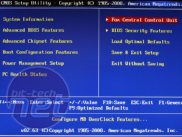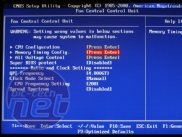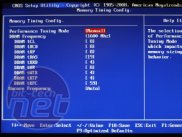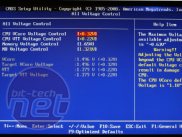BIOS
So, is the Renaissance a home theatre motherboard for trendy beatniks with lifestyles-a-digital or is there a real boisterous overclocker underneath? The answer inevitably lies in the BIOS. You may not be surprised to learn that the BIOS options are somewhat stripped down with considerably less tweaking options than Gigabyte’s considerably cheaper GA-EX58-UD3R.Experienced overclockers will find entering into the "Foxconn Central Control Unit" in the BIOS (it doesn't make a "whoosh" noise like a Star Trek door unfortunately) is a decidedly underwhelming affair. However all the essentials are present and the BIOS provides manual control over fundamentals such as memory frequency and latency, QPI frequency and CPU multiplier. However, there is not an option for manually adjusting the memory Command Rate for example - a fundamental omission.
Voltages are also very basic and you can only adjust the vCore, CPU VTT, northbridge and memory voltages. The incremental values in which they're adjusted are also slightly unusual: for example, the northbridge voltage is displayed in its complete value and can be cranked up in large increments of 0.28V. The QPI and northbridge voltages on the other hand are displayed in the amount of voltage being added to the stock voltage and can be upped in increments of +0.1V.
In compensation for this these obscurities, all four voltages are displayed below the adjustment options in their current complete values, with the numbers being pulled directly from the hardware monitor for your overclocking convenience and pleasure. Because the numbers are from the hardware monitor though, you will need to save and exit before the correct voltages are shown, as opposed to the figures being updated in real-time. This adds considerably to the pain-in-the-arse factor.
To be optimistic about using such a basic BIOS, it might be good for beginner overclockers don’t like the idea of having to sift through several gazillion BIOS options, biting their nails and wondering which one is going to fry their £400 CPU and motherboard combo. However there's no reason why more advanced options can't just be hidden behind an F-key for example.
The BIOS doesn’t contain any user profiles so if you lose all your settings you’ll have to re-enter them from scratch, and nor does it contain an in-BIOS BIOS flash utility either. Generally speaking, the auto recovery from a failed overclock was reliable and we only had to use the clear CMOS button on the PCB once during the test session and – unlike most of those used on older socket 775 motherboards – it worked like a charm. There's no doubt though that the bottom line is Foxconn clearly lags behind the rest of the competition in features because this BIOS is incredibly basic.
Overclocking
Going straight in for the 4GHz - kill so to speak - that we expect from a decent X58 motherboard proved successful after just a couple of tweaks. Our Core i7-920’s stock multiplier of 20 requires a QPI of 200MHz to hit this speed. We ramped the vCore up to 1.48V (+0.3V in the BIOS settings) the CPU VTT to 1.5V (+0.22V in the BIOS) and the Northbridge to 1.312V.We had to loosen up the memory timings from the stock speed testing set of 5-5-5-15 to CAS-8 and 8-8-19 to achieve the overclock stably. With these timings and the CPU at 4.0GHz the memory was happy to run at 1,600MHz.
The Renaissance would boot into Windows with a QPI of 205MHz for a 4.1GHz but the system would give us a BSoF (Blue Screen of Fail) after about ten minutes of Prime95. Despite a good deal of tweaking we were unable to stabilise the overclock at 4.1GHz. However it should be said that 4GHz is a good result, especially for a board with little in the way of BIOS options.
Dropping the multiplier down to 12x we managed to get the QPI frequency to an impressive 210MHz, showing that there is more potential headroom for bigger overclocks if you’ve got more time, better cooling or a more overclockable CPU. To run this QPI stably we had to add a little more juice to the VTT, upping it to 1.54V (+0.26V in the BIOS)
In Crysis, the board responded very well to the overclock indeed and managed to climb from the bottom of the pile to king of the hill when compared to the two the previous two Core i7 boards we've seen. Far Cry 2 was a similar deal with the minimum frame rate increasing by a respectable five frames per second with the CPU running stably at 4GHz..

MSI MPG Velox 100R Chassis Review
October 14 2021 | 15:04













Want to comment? Please log in.